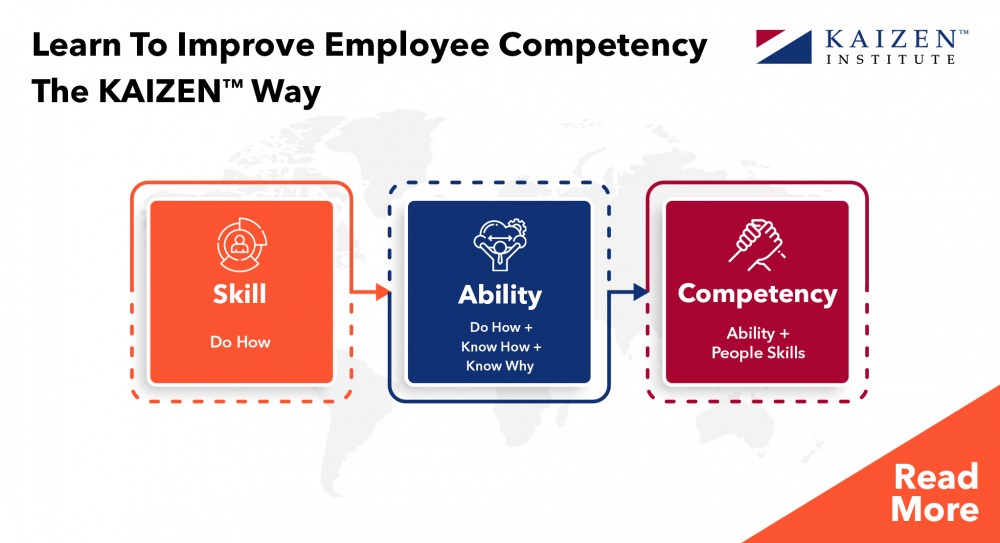You may probably be aware that "You can’t improve what you can’t measure, and you can’t measure what you can’t define".
As a leader, it is important for us to define and measure effectiveness as reflected via the performance of team members. The performance of team members performing the same job under similar conditions always vary; some members perform exceptionally well, whereas many are good to average and some deliver below-average performance. What do you think about why it is so? though there can be various reasons, a major cause is gap incompetence of the team members.
The question is: how you define the competence needed to perform the role as defined by the organization. Therefore, it is important for us to first understand what is competence?
Generally, we find that many people misinterpret skill as competence, but both are different, and it is essential to understand the subtle difference.
Skill is defined as the ability to do something well, whereas, competence is the ability to do something successfully or efficiently.
Competence is know-how plus skills plus behaviours, and attitudes that are needed to perform the role effectively.
Generally, during recruitment, we normally try to assess who is qualified/ competent to perform the job?’ In other words, we try to define what to measure?
Some people may think formal education is a reliable measure. Others may believe more in on-the-job training and minimum years of experience. Others might think that personal characteristics such as attitude hold the key to effective work behaviour.
All of these are important, but none seems sufficient to describe an ideal set of behaviours and traits needed for any role. Nor do they guarantee that individuals will perform to the standards and levels required by the organization.
At Kaizen Institute, we have defined a way of approaching competence development is to link individual performance to the business goals.
To accomplish this, we have defined the competencies, needed for the various roles in the organization. These competencies are integrated considering knowledge, skills, judgment, attributes, and standards that people need to perform a job effectively.
By defining a set of competencies and standards for each role the members do understand the kind of behaviours the organization values and needed to achieve the objectives.
Apart from members delivering what they are expected to, we can see many business benefits from linking personal performance with corporate goals and values.
Defining which competencies are necessary for success in your organization can help you do the following:
• Identify competency gaps and prepare individual CIP (competence improvement plan).
• Help in acquiring new talent.
• Evaluate performance through monthly performance system.
• Provide customized training and professional development.
Developing a competency framework requires efforts & time of experienced members.
While designing a competency framework it is must follow:
1. Involve the people doing the work – HR alone should not develop, nor it should give it to Line managers. To understand a role fully, it is important to involve members doing the job and get relevant inputs which makes someone successful in that job.
2. Communicate – People tend to get nervous whenever we talk about performance, competency. Therefore, it is important to share with them and let them know the purpose of it. The more you communicate, the easier will be the acceptance. This will help in executing it faster.
At Kaizen Institute India – Based on our business needs, we have created a matrix of competencies needed to achieve our business Goals and Objectives. We use this matrix periodically to identify the gaps in competence and tailor-made the development plan of our team members. In the current pandemic situation, we are using technology to impart knowledge and develop our team members.
The competency matrix is a great help to assess, maintain, and monitor the knowledge, skills, and attributes of our members. It also allows us to measure current competency levels to make sure our members have the requisite expertise needed to deliver the consulting assignments. It also helps HR to decide on talent recruitment, retention, and succession strategies.
In addition, by identifying the competency gaps, we define the budget and plan for the training and development for the year.
Similarly, while working with our clients we make sure to identify the competencies needed for the Leaders from client organization on following 4 parameters and work with individual Leader to develop his own CIP (Competence Improvement Plan.)
Example: Competency Matrix

Competence is at the core of performance management – if one can't define the competency expectations, one cannot hope to develop, monitor and guide human resources.
Author:

Mr. Arvind Kulkarni, Director HR at Kaizen Institute.
About Kaizen Institute
Kaizen Institute is the original and premier provider of KAIZEN™ services of Change Management, Business Excellence, Operational Excellence and Lean.
We support companies of all sizes in all market segments, providing them with a sustainable, competitive advantage. Our Vision is Improving the world with Everyone, Everywhere, Every Day – The KAIZEN™ Way. “KAIZEN™ means Change for the better.”
Kaizen Institute is a global organization which provides consulting and training services to companies represented in Europe, the Americas, Asia-Pacific, the Middle East, and Africa. We are currently operating in 60+ Countries for 35 years.
Want to know more about our services? Click Here












